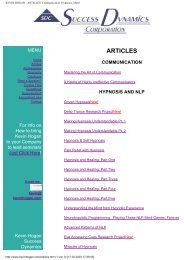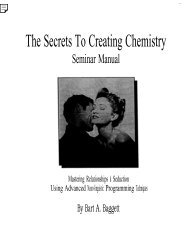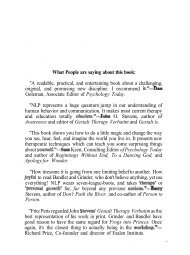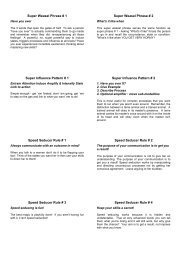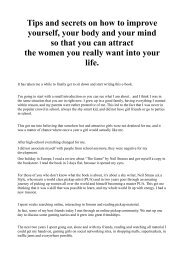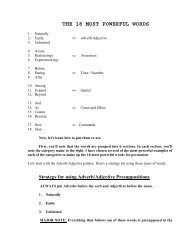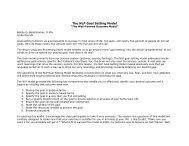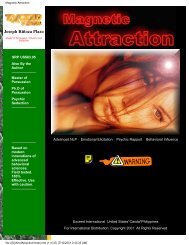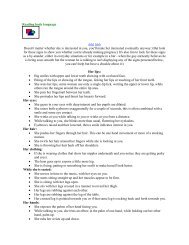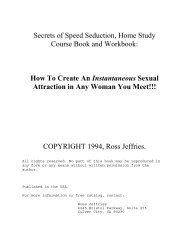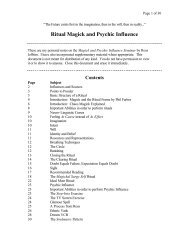A Pragmatic Guide To Communication & Change.pdf - NLP Info Centre
A Pragmatic Guide To Communication & Change.pdf - NLP Info Centre
A Pragmatic Guide To Communication & Change.pdf - NLP Info Centre
- No tags were found...
You also want an ePaper? Increase the reach of your titles
YUMPU automatically turns print PDFs into web optimized ePapers that Google loves.
ask you to describe them to me. Just think about them. Ready?"<br />
Section III. This final section requires some spontaneity on your part, as well as attention<br />
to what you do and to what you say: they will be different! Your goal will be to determine<br />
which of two simultaneously presented, incongruent (different) niessages is received by<br />
the person you are<br />
like, "termonacar" or "frucerah" (be inventive), then pause and wait for the response. This<br />
technique is particularly effective because in order to make sense of what he has heard,<br />
the person must draw upon information from his own model of the world. You have<br />
disrupted his expectations by saying a word that doesn't make sense, and the confusion<br />
that results from the surprise nonsense syllables creates a mildly stressful situation in<br />
which he will most likely retreat to his preferred system in order to make sense of what he<br />
has just experienced.<br />
1. Past event. "Can you remember your last (birthday, vacation, fun weekend)?" By<br />
asking the person to draw on his experience in a general way using the unspecified verb,<br />
"remember", you allow him to recall the experience in the way that is most comfortable to<br />
him, usually his preferred representational system. Again, allow time for the person to<br />
fully respond before going on the next question.<br />
2. Future event. "Where do you think you will be hying ten years from now?" Notice the<br />
use of the nonsensory-specific word "think." Observe which system the person uses in<br />
order to create the response to this question.<br />
working with "")Is will give YOU the person's represcntatiunal system hier•.cchy. Study<br />
these examples closely tmd practice them before trying them out. Notice tlott each step<br />
has two parts, "Say" and "Do," which overlap as indicated.<br />
1. Auditory, 6'i.su«l incnngrucnce.<br />
Say: "I'nr going to ask you to pay attention to your internal experience while we do<br />
(scr Do below) two things."<br />
Do: As you say the word "two" above, hold up three fingers for just a<br />
moment, then put them clown. Do this casually, and after a fell moments, ask<br />
the person, "What was the first thing you were aware of as I spoke. a moment<br />
ago?"<br />
The person's response to the question will indicate whether he was more alert to<br />
the audit(", portion of the esperiencc or to the visual portion. If he. points out the<br />
incongruity between what you said and what Yen did, he scores visual over<br />
auditory.<br />
2. K...esthetlc,Audaory int( ngruencc.<br />
Say: "Pay attention to your thoughts as 1 touch you em your right (see Do below)<br />
knee."<br />
Do: As you say the word •'right - -hove, retch nut and gently touch the person<br />
on his left knee. This is especially effective if you maintain the person's visual<br />
contact with your face, rather than with your hand. I)o this by wotelling the<br />
person's face ns yrni to, speaking and reaching t•r io touch his knee. When you<br />
or, hrough, ask , "What were you awtce of as I tnurhed you a nvoncut ago'?" if<br />
the person detects if,,. incongruity, he scores kim•sthetic over auditory.<br />
2. f-ut. Kinesthc(ic in..... urnre.<br />
128



